Update by Chris Avellone
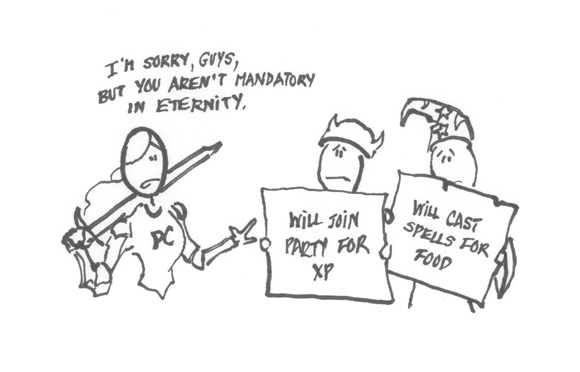
This week? Companions. I have been designing companions.
I lucked out, because I got to do companion design work for BOTH Eternity and Torment, so two birds, one stone. Or three companions, one lodestone? I don’t know.
Eternal Companion Facts
Some facts from our Eternity design documents that I wanted to say up front before going any further: thanks to backer support, Eternity supports 8, yes 8, pre-made companions and 8 hired adventurers (16 total). You can have up to 5 in the party at any point in time (the 6th/1st role is your player character, who, well, sort of has to be there, you know, because it’s your game). It’s a lot of writing.
We want to allow you to encounter all companions before the mid-point of the story. One issue we’ve found with introducing companions too late is that it doesn’t give players enough time to bond with them, and/or the player may have already formed a strong attachment to their other allies so much so there’s no physical or emotional room for more party members in their lives.
Each companion also has their own mini-arc and quest woven into the game as well, so be prepared - they have agendas of their own. You know, like real people.
Lastly in the fact train, we don’t force you to take anyone in your party. If you want them, take them. If you want to go to the Adventurer’s Hall and make your own, do it. Go solo. We don’t own you. We’re not trying to control you. Play how you want.
Narrative Update...
So a narrative update related to companions... Eric Fenstermaker (designer,
Fallout: New Vegas, also responsible for Boone and Veronica and worked on
NWN2: Mask of the Betrayer and... and... oh, just Google him) has been hard at work on the narrative, and it’s reached the point with the arc and themes that now seemed like a good time to introduce the companion supporting pillars to the process to take the story higher (...not necessarily in a “Can you Take Me Higher” Creed sort of way, since it’s not really a question, it’s more like, “yes, we will take you higher.”)
Over the past few months, I’ve been scrutinizing the systems and story documents for Eternity (and Torment), the themes, and also checking out the other companion briefs from the other designers. Aside from the companion designs I wrote, feedback has been wildly traded in the interests of making companions even better than their core concepts. It was my goal to read EVERYTHING about the narrative I could, even brainstorming - and in Torment’s case, novellas as well. Now it was time to work on the structure of the individual companions.
...and now on to Companion Design
We discussed companion design (
http://forums.obsidi...aracterization/) way back at the start of Eternity, so some points in this update will callback to this. There shouldn’t be a need for a refresher read unless you want to. The process for Eternity (and Torment) has followed these bulletpoints, and we’re holding true to our goals as well as expanding the design methodology as we go ahead.
The first and best place to start with companion design is the game systems. For companions, this means considering race, class, and their role in the conflict mechanics of the game. Knowing what class of character you’re making is key to building their history and personality. For example, in the case of Gann in NX1: Mask of the Betrayer, knowing his class before writing was a big help, and I can use that class’s list of abilities, class focus, and the abilities the class specializes in and weave it in with the backstory. The Eternity designers have been good about indicating the spread of classes and races for the companions and rationing those out during the process.
For Eternity, since combat is the primary challenge mechanic, one major goal is to make sure the companion is combat effective. Why would you take them in your party? How are they useful? In other instances of conflict mechanics (for example, dialogue or Tide reactivity in Torment), we also examine how the character is useful in terms of these challenges as well.
A Note About Challenge Mechanics
Really quick, I want to clarify what I meant about “challenge mechanics.” That doesn’t always mean combat – it’s whatever the primary challenge in the game is. If we were doing a Thief-style RPG, then stealth and avoiding detection becomes the primary challenge mechanic, not combat. Depending on the RPG and its range of challenges, a character can still be fairly weak in combat, but if that’s the case, we try to think of how they’re helpful with regards to the game’s other challenges (giving an edge in dialogue, healing, fast travel).
For all the characters I’ve seen or designed for games that don’t cater to at least one of the game’s primary challenge mechanics, those guys are often unpopular or unused because they’re not helping out with the systematic gameplay, regardless of how cool they might seem. And the more actively these characters can participate in the mechanics (vs. passive), the stronger their appeal.
Also at the same time, I try to be careful that the companion's skill set doesn’t overlap with the challenge roles of the other characters. We try to indicate in the companion briefs how each companion's challenge role is intended – one thing I learned as a pen-and-paper Gamemaster is you want to be careful about two players sharing the same role (Tank, Mage, Priest, etc.) – if one is clearly stronger than another, then the second one needs something else to make them stand out and be “special” in the party and fulfill an equally cool role in the party dynamic, otherwise one ends up getting upstaged by the other. And feelings get hurt. Which isn’t something you want in a game designed to entertain.
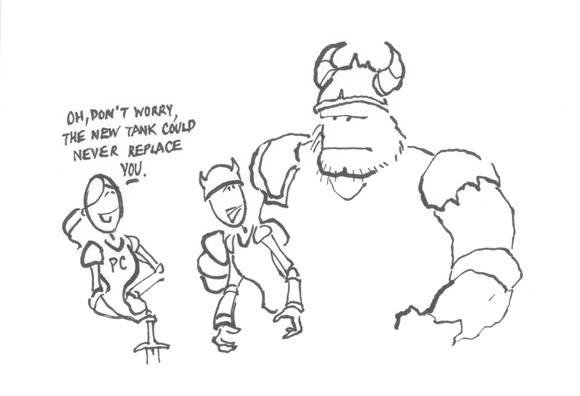
For Eternity, we’re setting it up so even if players choose the same classes as some companions, the companions are designed to assist those character types and make them more special (ciphers, for example, can chain, and even priests with the same religion can discuss theology and combo attacks).
In addition, we wanted to be careful about personality overlaps as well. I wanted to make sure any companion design didn't overlap with ideas or “concepts" of the other characters (or across projects – so for example, while I’m doing a Glaive for Torment, I’m not doing any fighters for Eternity) ...and that extends to personalities as well. As an example, I told Colin for Torment it might be a good idea if I didn't do a female rogue with a ruthless hidden agenda who can shape-shift according to your personality and have her/it be redundant with the Toy or the Cold, Calculating Jack in Torment.
So knowing the general class-focus, role, and personality for each, as well as ones that would be useful, we try to include in the character briefs and get that info to people as quickly as possible so everyone can get a sense for what direction to take their characters.
As for me, after much begging for the class itself and begging for the specific companion, I asked for the cipher. The cipher is near and dear to my heart, it felt like the first brand new class we were introducing that was tied into the soul mechanics of the Eternity world, and the freedom to explore it is a great opportunity.
Character Freedom
Both the Eternity and Torment leads have been strong advocates about letting designers channel their characters. If you are excited about an idea, they are willing to work with you to help realize that idea and help it fit into the world, without giving barriers to entry. In my opinion, the best GMs do this – rather than give you character sheets, they help you make a character you care about. In essence, companion design is a designer’s chance to design their very own player character that fits in with the world and the theme.
On Eternity, Eric has a strong theme for the story already. While not the original theme, Josh was accommodating and we all recognized that if another theme came to the forefront naturally through the writing process, it’s fine to alter it to make a stronger design. Having this theme clearly identified and supported in the narrative is good, but we’re taking care to make sure the companions can provide direct examples of the theme at work (or present counters or alternate viewpoints to it) - and the more, the better.
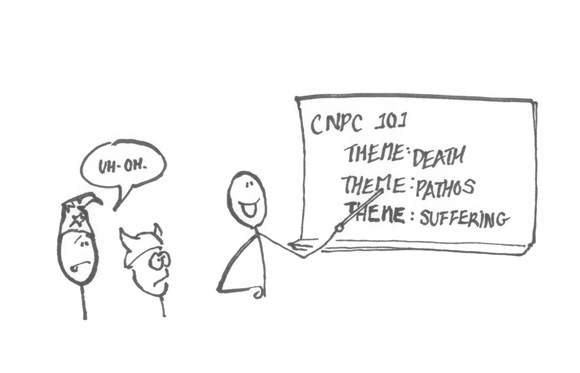
The companions cover a good range of culture and religion and factions in the game, which we hope to showcase more of in the future... the machinations of the world and the politics are prominent in the story (along with the magic system), and the characters showcase these elements very well.
Companion Iteration
There’s still plenty of work to do – like all design, iteration is key, and we have been doing passes of the characters to make them stronger. While the companions exist as individual entities, we also feel it’s important to do a pass of the companions to show how they relate to each other, which we feel is an important part of making the game Infinity Engine-esque, and it was a big part of the dynamics in Baldur’s Gate and Torment – describing how companions relate, fight, argue, or even act as sounding boards for both your character and each other’s viewpoints is an important part of creating a living world – and your party is very much the living world that follows you around.
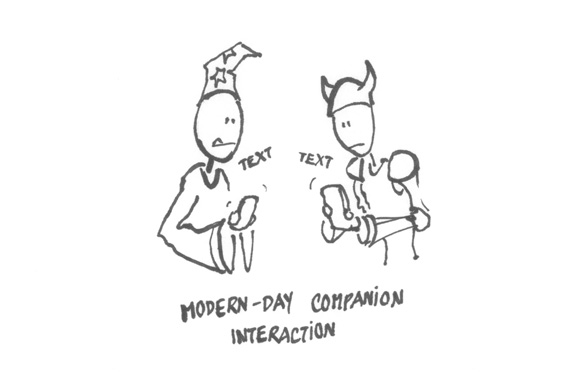
The work doesn’t stop there. A pass of the companions asking “why the players should care” is also something we like to make sure we have an answer to for each companion. While the answer of “good fighter” is an answer (and one that’s worked well for a number of companions in the past), we prefer to add more layers showcasing how they’re specifically adding to the player experience.
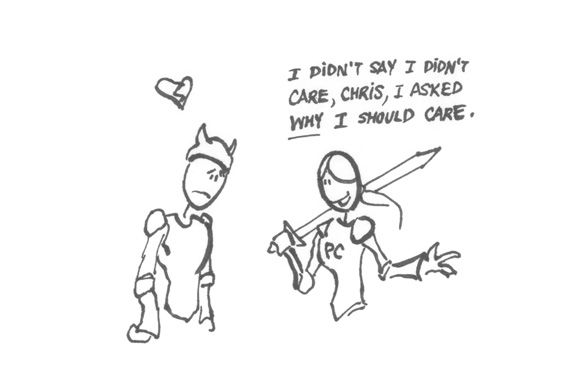
There are other finishing touches we like to add.
The companions have unique signature items (very Torment and Baldur’s Gate) in addition to their personalities and strong visual signatures as well. One comment we’ve always tried to include in these visual hooks is that because of the camera angles in the game, we want to make sure these visual hooks are easy for the players to see in the environment as well.
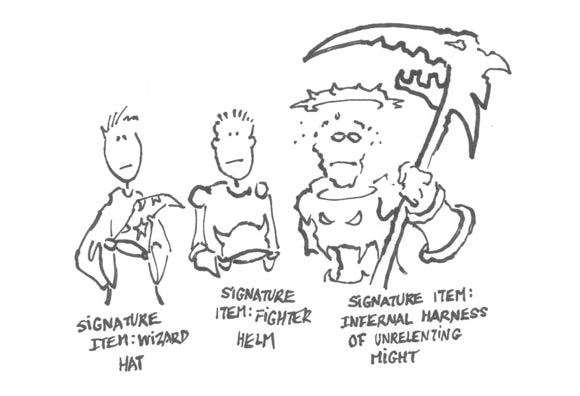
Also we’re doing what we can to get the area designers involved with not just the story, but companions as well. A good chunk of the game is dungeon exploration, and we felt that what the designers had done in NX1: Mask of the Betrayer in making sure that each companion had a significant interaction in a specific area was important for the story – and having areas that revolved around companions as well gave them and the dungeon design more strength. Right now, the companions already have strong internal conflicts (and religious and faction, if not inter-party), now tying those more to NPCs and dungeon explorations is one of our next targets.
With the companion design, we also tried to include narrative samples of analogies to that character that we’ve seen in other media or fiction that we feel help capture the character’s essence. Also, as we’re designing the characters, we include sample lines of dialogue when we can as another layer in the process so audio and other designers can get a sense of how the character sounds (both spoken and text-wise).
That’s all I can share about companions for the moment, and we’re looking forward to elaborating further as the game progresses.
If you have any thoughts or ideas on companion design, specific or general, feel free to post in our forums, we look forward to hearing from you!






![The Year of Incline [2014] Codex 2014](/forums/smiles/campaign_tags/campaign_incline2014.png)





























